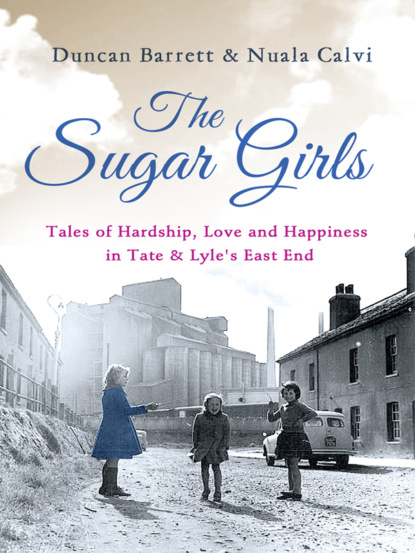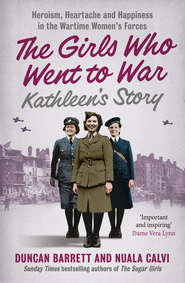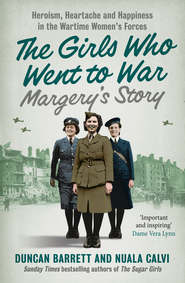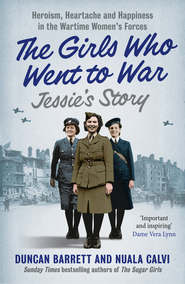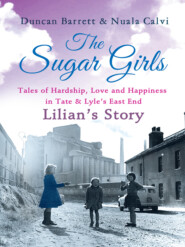По всем вопросам обращайтесь на: info@litportal.ru
(©) 2003-2024.
✖
The Sugar Girls: Tales of Hardship, Love and Happiness in Tate & Lyle’s East End
Настройки чтения
Размер шрифта
Высота строк
Поля
The Sugar Girls: Tales of Hardship, Love and Happiness in Tate & Lyle’s East End
Duncan Barrett
Nuala Calvi
Tales of Hardship, Love and Happiness in Tate & Lyle’s East End Factories. The Sugar Girls went straight to No.10 in the Sunday Times Bestseller List, spending five weeks in the top ten.On an autumn day in 1944, Ethel Alleyne walked the short distance from her house to Tate & Lyle’s refinery on the shining curve of the Thames. Looking up at the giant gates, Ethel felt like she had been preparing for this moment all her life. She smoothed down her frizzy hair, scraped a bit of dirt off the corner of her shoe and strode through.She was quite unprepared for the sight that met her eyes …In the years leading up to and after the Second World War thousands of women left school at fourteen to work in the bustling factories of London’s East End. Despite long hours, hard and often hazardous work, factory life afforded exciting opportunities for independence, friendship and romance. Of all the factories that lined the docks, it was at Tate & Lyle’s where you could earn the most generous wages and enjoy the best social life, and it was here where The Sugar Girls worked.Through the Blitz and on through the years of rationing The Sugar Girls kept Britain sweet. The work was back-breakingly hard, but Tate & Lyle was more than just a factory, it was a community, a calling, a place of love and support and an uproarious, tribal part of the East End. From young Ethel to love-worn Lillian, irrepressible Gladys to Miss Smith who tries to keep a workforce of flirtatious young men and women on the straight and narrow, this is an evocative, moving story of hunger, hardship and happiness.Tales of adversity, resilience and youthful high spirits are woven together to provide a moving insight into a lost way of life, as well as a timeless testament to the experience of being young and female.Also includes personal photographs of the sugar girls and life at the Tate & Lyle factory, available in the ebook edition only.
Duncan Barrett & Nuala Calvi
The Sugar Girls
Tales of Hardship, Love and Happiness in Tate & Lyle’s East End
Dedication
For Margaret Denby
Contents
Title Page
Dedication
Preface
1. Ethel
2. Lilian
3. Gladys
4. Ethel
5. Lilian
6. Gladys
7. Ethel
8. Lilian
9. Gladys
10. Ethel
11. Lilian
12. Gladys
13. Ethel
14. Joan
15. Lilian
16. Gladys
17. Joan
18. Ethel
19. Gladys
20. Joan
21. Ethel
22. Gladys
23. Joan
24. Ethel
Epilogue
Acknowledgements
Pictures (#litres_trial_promo)
About the Authors
Copyright
About the Publisher
Preface
Heading east out of the City of London, just past Poplar and the Isle of Dogs, you’ll find the artificial peninsula of Silvertown: a narrow strip of land two and a half miles long, sandwiched between the Royal Docks and the broad sweep of the Thames.
By the mid-twentieth century this area was home to a score of factories, from British Oil & Cake Mills at one end to Henley’s Cable Works at the other. The factories were a major employer, both for people living in the rows of slum houses in Silvertown and those in the surrounding areas north of the docks: Canning Town, Custom House and Plaistow. While the thriving docks provided work for the men in the local community, the factories offered employment for women as well.
When working-class girls left school there were a limited number of options available to them: dressmaking, service, clerical work perhaps, and, for the vast majority, a job in a factory. With the near full employment that followed the Second World War, most young people could simply take themselves along to a factory of their choice, ask for work and be hired on the spot. If they found they didn’t like it there, they could walk out at lunchtime and be taken on somewhere else before tea.
Among the most sought-after factories to work at were the two operated by Tate & Lyle, the Plaistow Wharf and Thames refineries, at either end of the Sugar Mile (so called because, in addition to the sugar and syrup they produced, Keiller’s jam factory was also located there). Tate & Lyle offered the best wages, generous bonuses three times a year, and a social life that was unrivalled in the neighbourhood thanks to the Tate Institute, a subsidised bar and entertainment hall. Unsurprisingly, the company inspired fierce loyalty among its employees – many young men and women working there in the post-war years were the fourth generation of their families to do so.
There were plenty of positions for young ‘sugar girls’, thanks to the many female-dominated departments: the great sugar-packing operation known as the Hesser Floor, the Blue Room where the sheets of paper were printed for the sugar bags, and the can-making and syrup-filling floors where the tins of Lyle’s Golden Syrup were put together and filled. The jobs could be heavy, exhausting and repetitive, but for the women who undertook them the rewards outweighed the hardships. Most stayed until they married or fell pregnant (the rules varied between departments as to when they were forced to leave). Nearly all of them looked back on their time at the factories as a kind of golden era in their lives – of independence, friendship and romance, before the responsibilities of marriage and motherhood took over.
Originally the two refineries had been run by rival companies. Henry Tate, a Liverpool grocer turned sugar magnate, put up his London factory in 1878, when much of Silvertown was still marshland. His great business adversary was Abram Lyle, who opened his own sugar and syrup factory a mile upstream five years later. Lyle was a pious Scot whose ruddy cheeks belied his commitment to teetotalism: he once declared he would rather see a son of his carried home dead than drunk.
For many decades the two firms competed in sugar production, but with an important unspoken agreement: the Lyles would not encroach on Tate’s trademark cubed sugar, while the Tates would not produce a single drop of the golden syrup the Lyles had invented. But a cold war developed between them, and when the Lyles heard rumours that the Tates were about to launch a syrup onto the market, they hastily knocked together a cube plant in response. Leaking word of its existence was enough to ensure that it never had to be used.
Duncan Barrett
Nuala Calvi
Tales of Hardship, Love and Happiness in Tate & Lyle’s East End Factories. The Sugar Girls went straight to No.10 in the Sunday Times Bestseller List, spending five weeks in the top ten.On an autumn day in 1944, Ethel Alleyne walked the short distance from her house to Tate & Lyle’s refinery on the shining curve of the Thames. Looking up at the giant gates, Ethel felt like she had been preparing for this moment all her life. She smoothed down her frizzy hair, scraped a bit of dirt off the corner of her shoe and strode through.She was quite unprepared for the sight that met her eyes …In the years leading up to and after the Second World War thousands of women left school at fourteen to work in the bustling factories of London’s East End. Despite long hours, hard and often hazardous work, factory life afforded exciting opportunities for independence, friendship and romance. Of all the factories that lined the docks, it was at Tate & Lyle’s where you could earn the most generous wages and enjoy the best social life, and it was here where The Sugar Girls worked.Through the Blitz and on through the years of rationing The Sugar Girls kept Britain sweet. The work was back-breakingly hard, but Tate & Lyle was more than just a factory, it was a community, a calling, a place of love and support and an uproarious, tribal part of the East End. From young Ethel to love-worn Lillian, irrepressible Gladys to Miss Smith who tries to keep a workforce of flirtatious young men and women on the straight and narrow, this is an evocative, moving story of hunger, hardship and happiness.Tales of adversity, resilience and youthful high spirits are woven together to provide a moving insight into a lost way of life, as well as a timeless testament to the experience of being young and female.Also includes personal photographs of the sugar girls and life at the Tate & Lyle factory, available in the ebook edition only.
Duncan Barrett & Nuala Calvi
The Sugar Girls
Tales of Hardship, Love and Happiness in Tate & Lyle’s East End
Dedication
For Margaret Denby
Contents
Title Page
Dedication
Preface
1. Ethel
2. Lilian
3. Gladys
4. Ethel
5. Lilian
6. Gladys
7. Ethel
8. Lilian
9. Gladys
10. Ethel
11. Lilian
12. Gladys
13. Ethel
14. Joan
15. Lilian
16. Gladys
17. Joan
18. Ethel
19. Gladys
20. Joan
21. Ethel
22. Gladys
23. Joan
24. Ethel
Epilogue
Acknowledgements
Pictures (#litres_trial_promo)
About the Authors
Copyright
About the Publisher
Preface
Heading east out of the City of London, just past Poplar and the Isle of Dogs, you’ll find the artificial peninsula of Silvertown: a narrow strip of land two and a half miles long, sandwiched between the Royal Docks and the broad sweep of the Thames.
By the mid-twentieth century this area was home to a score of factories, from British Oil & Cake Mills at one end to Henley’s Cable Works at the other. The factories were a major employer, both for people living in the rows of slum houses in Silvertown and those in the surrounding areas north of the docks: Canning Town, Custom House and Plaistow. While the thriving docks provided work for the men in the local community, the factories offered employment for women as well.
When working-class girls left school there were a limited number of options available to them: dressmaking, service, clerical work perhaps, and, for the vast majority, a job in a factory. With the near full employment that followed the Second World War, most young people could simply take themselves along to a factory of their choice, ask for work and be hired on the spot. If they found they didn’t like it there, they could walk out at lunchtime and be taken on somewhere else before tea.
Among the most sought-after factories to work at were the two operated by Tate & Lyle, the Plaistow Wharf and Thames refineries, at either end of the Sugar Mile (so called because, in addition to the sugar and syrup they produced, Keiller’s jam factory was also located there). Tate & Lyle offered the best wages, generous bonuses three times a year, and a social life that was unrivalled in the neighbourhood thanks to the Tate Institute, a subsidised bar and entertainment hall. Unsurprisingly, the company inspired fierce loyalty among its employees – many young men and women working there in the post-war years were the fourth generation of their families to do so.
There were plenty of positions for young ‘sugar girls’, thanks to the many female-dominated departments: the great sugar-packing operation known as the Hesser Floor, the Blue Room where the sheets of paper were printed for the sugar bags, and the can-making and syrup-filling floors where the tins of Lyle’s Golden Syrup were put together and filled. The jobs could be heavy, exhausting and repetitive, but for the women who undertook them the rewards outweighed the hardships. Most stayed until they married or fell pregnant (the rules varied between departments as to when they were forced to leave). Nearly all of them looked back on their time at the factories as a kind of golden era in their lives – of independence, friendship and romance, before the responsibilities of marriage and motherhood took over.
Originally the two refineries had been run by rival companies. Henry Tate, a Liverpool grocer turned sugar magnate, put up his London factory in 1878, when much of Silvertown was still marshland. His great business adversary was Abram Lyle, who opened his own sugar and syrup factory a mile upstream five years later. Lyle was a pious Scot whose ruddy cheeks belied his commitment to teetotalism: he once declared he would rather see a son of his carried home dead than drunk.
For many decades the two firms competed in sugar production, but with an important unspoken agreement: the Lyles would not encroach on Tate’s trademark cubed sugar, while the Tates would not produce a single drop of the golden syrup the Lyles had invented. But a cold war developed between them, and when the Lyles heard rumours that the Tates were about to launch a syrup onto the market, they hastily knocked together a cube plant in response. Leaking word of its existence was enough to ensure that it never had to be used.





